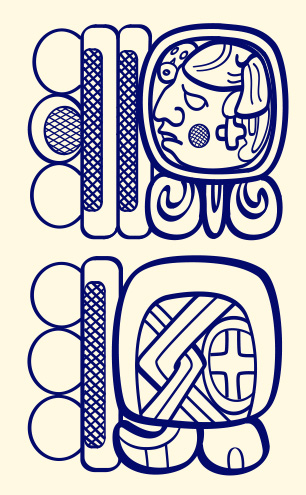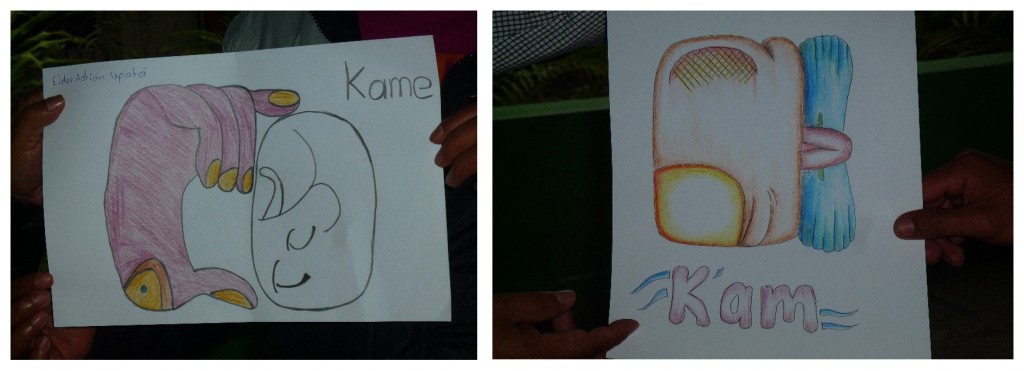GLYPH WORKSHIP FOR MAYAS IN THE ACHÍ LINGUISTIC COMMUNITY
By
Andrés Cholotío García, Executive Director PLFM Foundation
Abstract
Date and place: Event took place in Cubulco, Baja Verapaz on March 1, 2015.
Theme: How to write in tz’iib’ (hieroglyphs).
Coordination by: Andrés Cholotío García and the Achí linguistic community
Instructor: Andrés Cholotío García
Assisted by: Nidia Minerva Padilla Sapón
TALLER SOBRE GLIFOS PARA MAYA REALIZADA EN LA COMUNIDAD LINGÜÍSTICA ACHI
Por
Andrés Cholotío Garcia, Director Ejecutivo de la Fundación PLFM
Resumen
Fecha y lugar: Desarrollado en Cubulco, Baja Verapaz el día 1 marzo del 2015.
Tema: como se escribe en tz’iib’ (jeroglíficos).
Coordinación: Andrés Cholotío García y la comunidad lingüística Achi
Expositor: Andrés Cholotío García.
Asistencia: Nidia Minerva Padilla Sapón
Overall Objective
- Acquire and develop knowledge in tz’iib (ancient writing) of our grandmothers and grandfathers by means of using it.
Specific Objectives
- Identify the syllabary developed by epigraphers, to begin to write certain words.
- Identify mixed spellings to understand the combination of syllables and logograms.
- To write certain words with logograms that had been previously identified in texts or monuments.
The Event
Prior to the event taking place, we communicated with MAM to see if it was possible to finance the workshop in the Achí linguistic community, because a group of young people were putting together a certification program in linguistics and wanted to know about tz’iib (hieroglyphs) to enrich their knowledge of the ancient writing.
Since this is a group of young people, it seemed necessary to give some history of how decipherment was started by the epigraphers and the methods they used. To understand this part, we used linguistic analysis of one of the Maya languages, identifying the verb roots and their inflections. This helps to understand how you can identify elements in the glyphs that are discovered.
For the workshop we used material developed by our colleague Hector Xol for various language communities in which he had produced workshops, a document in which he demonstrated a word in tz’iib’ and how it was interpreted in the various Mayan languages of Guatemala.

Andrés Cholotío (in front) gives instruction; Alejandro Teletor Velásquez (left) president Achí Linguistic Community.
It was explained where glyphs could be found: in codices, on temples, murals, lintels, vases, stelae, and more. Within the decipherments that have been made we could find the syllables from the syllabary, also the logograms that represent words. Also we made a presentation of the syllables that are found in contemporary writing but not found in the glyphs, such as qa, q’a, and ra.
A presentation was made of the structure of words that are in use today and with these it was possible to create some examples of glyphic spelling, like witz, ajaw, ixik, nal, and others. The structure of combined glyphs was shown, how they can be written without changing the original order of the parts, or how one can choose between various options in glyph order presented during the lessons.
Principles of Reading/Writing
1. Omission of pronunciation of the final vowel.
The writing may be done with whole syllables but when reading, the final vowel is omitted from the final syllable when the word ends in a consonant.
2. Substitution principle.
This principle works to show how words form: some with simple vowels, some with long vowels.
3. Principle of repetition.
This principle shows us that many of the glyph compounds that are found, in which there are glyphs repeated, are not really such; what happens is that they are duplicating the consonants, and for this reason we find glyphs repeated.
4. Mixing of signs.
The mixing of signs are those glyphs in which we find within one single glyph various glyphs embedded. This kind of art is very important and it is admirable how they managed it.
5. Polyvalence.
Polyvalence is when we find a sign with more than one meaning that has been found during the process of decipherment.
Another theme tackled was Maya numeration.
The numeration in Maya civilization was very important and within the ancient writing there were two forms: one was bars and dots and the other was the head variants with their respective identifications.
Exercises
After presenting the subjects, a number of exercises were done; first, to copy a glyph whose structure had already been given, then identifying a glyph and writing its name in Latin characters.
After the exercises, various illustrations were presented by the students showing the use of syllables and logograms along with explanations of how the exercises were done.
Conclusions
The participation of the young people and the results they achieved was very important.
There should be a follow-up workshop for them to continue learning the writing.
The PLFM Foundation has made a commitment for a follow-up later this year.
The willingness and eagerness that these youth have for learning the writing of their grandmothers and grandfathers is very impressive.
Objetivo General
- Adquirir y desarrollar los conocimientos en el tz’iib’ (escritura antigua) de nuestras abuelas y abuelos mediante el uso de la misma.
Objetivos Específicos
- Identificar el silabario actualizado por los epigrafistas, para empezar a escribir algunas palabras.
- Identificar ortografía mixta para comprender la combinación entre sílaba y logograma.
- Escribir algunas palabras con signos logogramas, que han sido identificados anteriormente en algunos textos o monumentos.
La Actividad
Previo del desarrollo del taller se coordinó con MAM para poder ver un financiamiento del taller en la comunidad lingüística Achi, porque un grupo de jóvenes están llevando un diplomado en lingüística y así pueden ellos conocer un poco de la escritura tz’iib’ (jeroglíficos) y enriquecer los conocimientos dentro de esta escritura antigua.
Como es un grupo de jóvenes, se vio la necesidad de dar un poco de historia de cómo se comenzó el desciframiento por los epigrafistas y el método que utilizaron.
Para entender esta parte, fue necesario que se hiciera un análisis lingüístico de uno de los idiomas mayas y como se podía identificar la raíz verbal y sus inflexiones. Esto ayuda para entender cómo se podía identificar cada uno de los elementos de los glifos que se descubría.
Para el taller se utilizó un material que el compañero Hector Xol ha elaborado para las distintas comunidades en donde se ha desarrollado los talleres. Es un documento en donde empieza a enseñar sobre el vocablo tz’iib’ y cuál es la interpretación en cada uno de los idiomas que se habla en nuestros país.

Andrés Cholotío (frente) hizo la presentación; Alejandro Teletor Velásquez (a la izquierda), presidente comunidad lingüística achi’.
Se explicó en donde podíamos encontrar esta escritura: en los códices, templos, murales, dinteles, vasijas, estelas y otros. Dentro de los desciframientos que se han hecho podemos encontrar las sílabas con el cuadro de silabario, también las logogramas que representan una palabra. También se hizo una presentación de las sílabas actuales que no se encuentra en la escritura que son la qa, q’a y la ra.
Se hiso una presentación de las estructuras de las palabras que se encontrado actualmente y con eso se puede trabajar y hacer algunos ejemplos de escritura en glifos, por ejemplo witz, ajaw, ixik, nal, y otros. Se explicó la estructura de los bloques de glifos, como se puede ser escrito para no alterar el orden original, u optar por las opciones de orden los que se les han presentado durante la explicación.
Principios de Lectura/Escritura
1. Omisión de pronunciación de la vocal de la última sílaba
Las escritura de las palabras siempre se escriben las sílabas pero en la lectura se omite la vocal de la última sílaba por regla que tiene esta escritura si su terminación es consonante.
2. Principio de sustitución
Este principio sirve para ver cómo funcionan las palabras, algunas con vocal simple y otros con vocal prolongada.
3. Principio de Repetición
Este principio nos enseña que muchas de los complejos de glifos encontrados donde hay repetición de glifos, no es tanto así, lo que pasa es que hay reafirmación de algunas de las consonantes, por esa razón que encontramos glifos repetidos.
4. Mezcla de signos
La mezcla de signos son aquellos glifos en donde encontramos en un solo glifo varios glifos incrustados. Es muy importante este tipo de arte y como se manejó en su tiempo, por lo que es de admirar.
5. Polivalencia
Polivalencia es cuando encontramos un signo con más que un significado que se han encontrado en las investigaciones de desciframiento que se ha realizado.
Otro de los temas que se abordó fue la numeración.
La numeración en la civilización maya fue muy importante y dentro de la escritura hay dos formas: uno es de puntos y barras y el otro es de variantes de cabezas con sus respectivas identificaciones.
Ejercicios
Después de dar los contenidos se desarrolló una buena cantidad de ejercicios, primero copiar un glifo que ya está con una estructura dada. Entonces, identificación del glifo y escribir su nombre en escritura latino.
Después de los ejercicios se presentaron varias láminas en donde se han sacado las sílabas y logogramas junto con las explicaciones y como lo demostraron en los ejercicios hechos.
Conclusiones
La participación de los jóvenes y los resultados logrados con ellos fue muy importante.
Hay que darle seguimiento al taller para que se vaya apropiando el tz’iib’.
La Fundación PLFM se comprometió en el seguimiento de este taller para este año.
La disponibilidad que tienen los jóvenes de conocer la forma de escribir de las abuelas y abuelos es muy impresionante.









